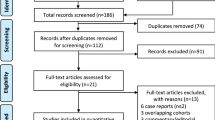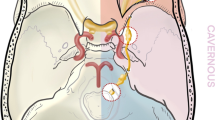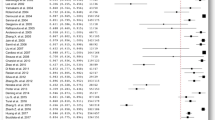Abstract
There has been a steady increase of vestibular schwannoma (VS) research in the body of literature. To delineate the most impactful works on VS, a bibliometric analysis is warranted. The Thomson Reuters Web of Sciences database was queried to identify all articles on VS published to June 2020. The articles were sorted in descending order of the number of citations. Titles and abstracts of the top 100 most-cited articles were screened to identify the research area, publication year, author, and country of publication. Our query yielded 6477 research publications. The 100 most-cited articles were cited 15804 times. The most productive decade was the 1990s (40% of the top 100 articles). Twenty-five journals contributed to all included articles. Journal of Neurosurgery contributed most of the articles (20%). Most common contributing country was the USA (60%). “Operative treatment” was the most common research topic (68%), followed by other aspects such as medical management (13%), epidemiology (12%), diagnosis (5%), or translational medicine (2%). The current analysis highlights the importance of the multimodal approach in the study and treatment of VS. While emphasizing the relevance of including highly cited articles in the current education of VS, our results point out the deficiency in certain research areas with high impact in other fields of neuro-oncology, such as translational medicine and molecular epigenetics.



Similar content being viewed by others
Data availability
N/A
References
Ahn MS, Jackler RK, Lustig LR (1996) The early history of the neurofibromatosis. Evolution of the concept of neurofibromatosis type 2. Arch Otolaryngol Head Neck Surg 122:1240–1249. https://doi.org/10.1001/archotol.1996.01890230086016
Akmal M, Hasnain N, Rehan A, Iqbal U, Hashmi S, Fatima K, Farooq MZ, Khosa F, Siddiqi J, Khan MK (2020) Glioblastome multiforme: a bibliometric analysis. World Neurosurg 136:270–282. https://doi.org/10.1016/j.wneu.2020.01.027
Almutairi O, Albakr A, Al-Habib A, Ajlan A (2017) The top-100 most-cited articles on meningioma. World Neurosurg 107:1025–1032.e5. https://doi.org/10.1016/j.wneu.2017.08.021
Alotaibi NM, Nassiri F, Badhiwala JH, Witiw CD, Ibrahim GM, Macdonald RL, Lozano AM (2016) The most cited works in aneurysmal subarachnoid hemorrhage: a bibliometric analysis of the 100 most cited articles. World NeurosurG 89:587–592.e6. https://doi.org/10.1016/j.wneu.2015.11.072
Bergo E, Lombardi G, Guglieri I, Capovilla E, Pambuku A, Zagone V (2019) Neurocognitive functions and health-related quality of life in glioblastoma patients: a concise review of the literature. Eur J Cancer Care (Engl) 28:e12410. https://doi.org/10.1111/ecc.12410
Bohl MA, Ponce FA (2017) Assessing the relevancy of highly cited works in neurosurgery. Part I: The 100 most relevant papers in Neurosurgical Journals. World Neurosurg 104:927–938. https://doi.org/10.1016/j.wneu.2017.03.149
Cheng W, Kang Q, Xiao Q (2019) Bibliometric analysis of the top 100 influential studies on carotid artery stenting. World Neurosurg 122:e1321–e1331. https://doi.org/10.1016/j.wneu.2018.11.042
Chiang C-C, Guo S-E, Huang K-C, Lee B-O, Fan J-Y (2016) Trajectories and associated factors of quality of life, global outcome, and post-concussion symptoms in the first year following mild traumatic brain injury. Qual Life Res 25:2009–2019. https://doi.org/10.1007/s11136-015-1215-0
Cordova C, Kurz SC (2020) Advances in molecular classification and therapeutic opportunities in meningiomas. Curr Oncol Rep 22:84. https://doi.org/10.1007/s11912-020-00937-4
Dandy WE (1925) An operation for the total removal of cerebellopontine (acoustic) tumors. Surg Gynecol Obstet 129–148
Grosu A-L, Oestreicher E, Fauser C, Lumenta C, Arnold WJ, Molls M (2008) Vestibular schwannoma (acoustic neuroma). In: Seegenschmiedt MH, Makoski H-B, Trott K-R, Brady LW (eds) Radiotherapy for non-malignant disorders. Springer, Berlin Heidelberg, pp 629–652
Guo X, Gao L, Wang Z, Feng C, Xing B (2018) Top 100 most-cited articles on pituitary adenoma: a bibliometric analysis. World NeurosurG 116:e1153–e1167. https://doi.org/10.1016/j.wneu.2018.05.189
Gupta VK, Thakker A, Gupta KK (2020) Vestibular schwannoma: what we know and where we are heading. Head and Neck Pathol 14:1058–1066. https://doi.org/10.1007/s12105-020-01155-x
Håvik AL, Bruland O, Myrseth E, Miletic H, Aarhus M, Knappskog P-M, Lund-Johansen M (2018) Genetic landscape of sporadic vestibular schwannoma. J Neurosurg 128:911–922. https://doi.org/10.3171/2016.10.JNS161384
Huang Y, Zhao T, Reidler JS, Chen X, Zhang H, Shao H, Jin M, Zhang J (2020) The top 100 most-cited articles on kyphoplasty and vertebroplasty. World Neurosurg 135:e435–e446. https://doi.org/10.1016/j.wneu.2019.12.014
Jones DTW, Kieran MW, Bouffet E, Alexandrescu S, Bandopadhayay P, Bornhorst M, Ellison D, Fangusaro J, Fisher MJ, Foreman N, Fouladi M, Hargrave D, Hawkins C, Jabado N, Massimino M, Mueller S, Perilongo G, Schouten van Meeteren AYN, Tabori U, Warren K, Waanders AJ, Walker D, Weiss W, Witt O, Wright K, Zhu Y, Bowers DC, Pfister SM, Packer RJ (2018) Pediatric low-grade gliomas: next biologically driven steps. Neuro-oncology 20:160–173. https://doi.org/10.1093/neuonc/nox141
Jusue-Torres I, Hulbert A, Germanwala AA, Patel CR, Germanwala AV (2018) The 100 most-cited reports about craniopharyngioma. World NeurosurG 119:e910–e921. https://doi.org/10.1016/j.wneu.2018.08.004
Jusue-Torres I, Mendoza JE, Brock MV, Hulbert A (2020) The 100 most cited papers about cancer epigenetics. Cureus. https://doi.org/10.7759/cureus.7623
Komatsuzaki A, Tsunoda A (2001) Nerve origin of the acoustic neuroma. J Laryngol Otol 115:376–379. https://doi.org/10.1258/0022215011907910
Merlin T, Weston A, Tooher R (2009) Extending an evidence hierarchy to include topics other than treatment: revising the Australian “levels of evidence”. BMC Med Res Methodol 9:34. https://doi.org/10.1186/1471-2288-9-34
Moed HF (2009) New developments in the use of citation analysis in research evaluation. Arch Immunol Ther Exp 57:13–18. https://doi.org/10.1007/s00005-009-0001-5
Nasir SAR, Gilani JA, Fatima K, Faheem U, Kazmi O, Siddiqi J, Khosa F (2018) Top 100 most-cited articles on spontaneous intracerebral hemorrhage: a bibliometric analysis. World Neurosurg 110:445–449.e6. https://doi.org/10.1016/j.wneu.2017.09.077
Niranjan A, Lunsford LD (2000) Radiosurgery: where we were, are, and may be in the third millennium. Neurosurgery 46:531–543. https://doi.org/10.1097/00006123-200003000-00002
Ostrom QT, Cioffi G, Gittleman H, Patil N, Waite K, Kruchko C, Barnholtz-Sloan JS (2019) CBTRUS statistical report: primary brain and other central nervous system tumors diagnosed in the United States in 2012-2016. Neuro-oncology 21:v1–v100. https://doi.org/10.1093/neuonc/noz150
Panagopoulos D, Karydakis P, Giakoumettis D, Themistocleous M (2020) The 100 most cited papers about brain metastases. World Neurosurg 138:98–114. https://doi.org/10.1016/j.wneu.2020.02.156
Passier PECA, Visser-Meily JMA, Rinkel GJE, Lindeman E, Post MWM (2013) Determinants of health-related quality of life after aneurysmal subarachnoid hemorrhage: a systematic review. Qual Life Res 22:1027–1043. https://doi.org/10.1007/s11136-012-0236-1
Ponce FA, Lozano AM (2010) Highly cited works in neurosurgery. Part I: the 100 top-cited papers in neurosurgical journals. J Neurosurg 112:223–232. https://doi.org/10.3171/2009.12.JNS091599
Rajaraman P, Hutchinson A, Wichner S, Black PM, Fine HA, Loeffler JS, Selker RG, Shapiro WR, Rothman N, Linet MS, Inskip PD (2010) DNA repair gene polymorphisms and risk of adult meningioma, glioma, and acoustic neuroma. Neuro-Oncology 12:37–48. https://doi.org/10.1093/neuonc/nop012
Seizinger BR, Martuza RL, Gusella JF (1986) Loss of genes on chromosome 22 in tumorigenesis of human acoustic neuroma. Nature 322:644–647. https://doi.org/10.1038/322644a0
Singh K, Singh MP, Cl T, Rao K, Singh K, Singh A (2015) Role of magnetic resonance imaging in evaluation of cerebellopontine angle schwannomas. Indian J Otolaryngol Head Neck Surg 67:21–27. https://doi.org/10.1007/s12070-014-0736-0
Venable GT, Shepherd BA, Loftis CM, McClatchy SG, Roberts ML, Fillinger ME, Tansey JB, Klimo P (2016) Bradford’s law: identification of the core journals for neurosurgery and its subspecialties. J Neurosurg 124:569–579. https://doi.org/10.3171/2015.3.JNS15149
Whitney E, Mahato D, Odell T, Khan YR, Siddiqi J (2019) The 100-most cited articles about craniectomy and hemicraniectomy: a bibliometric analysis. Cureus 11:e5524. https://doi.org/10.7759/cureus.5524
Yoshimoto Y (2005) Systematic review of the natural history of vestibular schwannoma. J Neurosurg 103:59–63. https://doi.org/10.3171/jns.2005.103.1.0059
Code availability
Bibliographic review
Author information
Authors and Affiliations
Contributions
Conception and design of study: Rafael Martinez-Perez. Acquisition of data: Rafael Martinez-Perez, Timothy Ung. Analysis and/or interpretation of data: Rafael Martinez-Perez, Timothy Ung. Drafting the manuscript: Rafael Martinez-Perez. Revising the manuscript critically for important intellectual content: Timothy Ung, Samy Youssef. Approval of the version of the manuscript to be published: all authors.
Corresponding authors
Ethics declarations
Ethical approval and informed consent
Informed consent and ethical approval were not deemed necessary by the local ethics in view of the design of the study (review).
Conflict of interest
A. Samy Youssef is a consultant for Stryker Corp and has received royalties from Mizuho America.
Additional information
Publisher’s note
Springer Nature remains neutral with regard to jurisdictional claims in published maps and institutional affiliations.
This manuscript has not been previously published in whole or in part or submitted elsewhere for review.
In brief
We performed a bibliographic analysis of the existent literature on vestibular schwannoma. We sought to provide clinicians and researchers with an updated understanding of the evolving landscape in the clinical and research practices of VS. Our results should not only serve an updated reference for researchers but it should also elicit the current limitations in VS research. Unlike other neurooncological diseases, basic research is still marginal among the most relevant studies on VS and the majority of studies are focused on assessing the role of different treatment modalities. This review emphasizes the need to promote new research projects that encompass the study of molecular mechanisms and other basic sciences. This strategy would lead to the elucidation of novel tumor biomolecular mechanisms and the development of new epigenetic-based targeted therapeutic tools.
Supplementary information
ESM 1
(DOCX 25 kb)
Rights and permissions
About this article
Cite this article
Martinez-Perez, R., Ung, T.H. & Youssef, A.S. The 100 most-cited articles on vestibular schwannoma: historical perspectives, current limitations, and future research directions. Neurosurg Rev 44, 2965–2975 (2021). https://doi.org/10.1007/s10143-021-01487-4
Received:
Revised:
Accepted:
Published:
Issue Date:
DOI: https://doi.org/10.1007/s10143-021-01487-4




